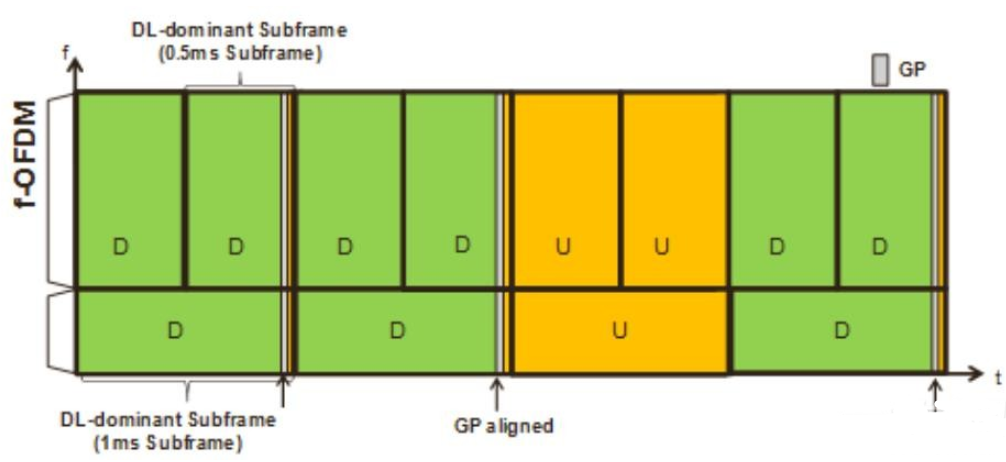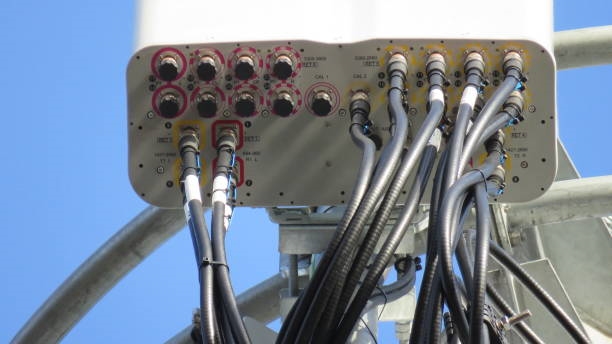Overview
This article summarizes a Huawei-proposed approach to NR frame structure design, focusing on flexible frame configuration and coexistence to meet diverse deployment scenarios. It discusses supporting multiple numerologies within a contiguous spectrum block, subframe types and durations, self-contained subframes, channelization, configurable HARQ timing, TDD uplink/downlink configurations, unlicensed spectrum and flexible duplex support, and frame considerations for large-scale MIMO.
Flexible Frame Structure and Coexistence
NR must support a variety of applications and deployment scenarios and therefore multiple numerologies. The frame structure should be highly flexible and configurable for different numerologies, in parameters such as subcarrier spacing, cyclic prefix length, subframe duration, and guard period (GP) duration. Supporting multiple numerologies within a single contiguous spectrum block enables flexible resource multiplexing across services.
By introducing filtered OFDM (f-OFDM), coexistence of multiple frame configurations can be supported. When different numerologies are used across subbands, f-OFDM can separate contiguous spectrum into different carriers and mitigate inter-carrier interference. Figure 1 illustrates an example of multi-frame coexistence across paired bands. Several frame configurations occupy different carrier portions, for example an eMBB unicast with normal CP, MBMS with extended CP, and mMTC with smaller subcarrier spacing.

For unpaired bands, GP alignment is required to avoid DL/UL cross-link interference and simplify coexistence. Figure 2 shows an example of multi-frame coexistence in unpaired spectrum with aligned GP positions.

Subframe Duration and Scaling with Subcarrier Spacing
Subframe duration is defined from a 1 ms base time unit corresponding to a base subcarrier spacing f0 and contains a given number of OFDM symbols for a specified CP length. Subframe duration then scales with subcarrier spacing, allowing support for other durations such as 0.5 ms, 0.25 ms, and 0.125 ms. The number of OFDM symbols and the associated time-domain structure are kept as consistent as possible and can, to some extent, be independent of the exact subcarrier spacing. At higher frequencies, larger subcarrier spacing combined with preserving a reasonable number of OFDM symbols per subframe enables shorter subframe durations.
The following examples show scaling of subframe duration with subcarrier spacing. A 0.5 ms (example 1) or 1 ms (example 2) subframe duration could correspond to a given CP configuration (for example, 7 or 14 OFDM symbols with normal CP) with 15 kHz subcarrier spacing. When subcarrier spacing is increased to 30 kHz, the subframe duration can be configured to 0.25 ms (example 1) or 0.5 ms (example 2). Examples 1 and 2 can be applied to different services: for instance, a 1 ms subframe with 14 OFDM symbols for eMBB non-critical services and a 0.5 ms subframe with 7 OFDM symbols for uRLLC. Shorter subframe durations with larger subcarrier spacing are also an option for URLLC services.

Wireless Frame Length Alternatives
For defining the wireless frame, consider the following alternatives:
- Retain the LTE length of 10 ms.
- Use TRF = T0 * m, where TRF is the wireless frame length, T0 is a base duration to be determined, and m is an integer selected from a set of possible positive values.
Option 1 allows NR to inherit an LTE-compatible design. Option 2 provides flexibility for new services and numerologies. Wireless frame length can be defined relative to beam scan cycles, periodicity of common channels, or UL-DL configuration. Note that the number of candidate UL-DL configurations increases with the number of subframes in the wireless frame; therefore, UL-DL configurations are preferably defined based on a fixed number of subframes, which may not match a wireless frame of fixed duration.
 ALLPCB
ALLPCB







